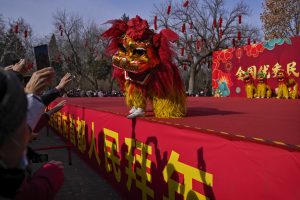The China Central Television (CCTV) annual Spring Festival Gala, the most-watched TV program in the world, attracts a viewership that approaches at least a third of China’s total population of 1.4 billion, far exceeding similar extravaganzas such as the Eurovision Song Contest. Since its inception in 1983, the Gala has become a defining element of the contemporary Chinese Spring Festival experience.
The hours-long program, running from early evening to midnight, involves thousands of people in the production crew and has become a central activity for many Chinese families on Lunar New Year’s Eve. The performances, which include dancing, singing, skits, and acrobatics, are highly selective, with competitions for spots often starting months in advance, and the final list being published only at the last minute.
The Gala reflects much of the “collective sentiment” that China’s government aims to foster and the self-image it wishes to project. In the past, the gala has highlighted national achievements or goals, including the construction of a high-speed railway to Tibet in 2005, the launch of aerospace exploration, and the promotion of new public health norms. Although in recent years it has seen a decline in viewership due to criticisms of being too prosaic, this year’s Gala, celebrating the year of the dragon – a symbol often associated with China’s cultural heritage – received the highest viewership in six years.
A significant challenge for Western policymakers and scholars in understanding China, as well as authoritarian states in general, is distinguishing whether political messaging is intended for foreign audiences or is dramatized language aimed at pacifying the domestic audience and bolstering their confidence in the regime. The Gala primarily serves the latter purpose. It provides an excellent opportunity to discern what the Chinese government wants its ordinary citizens to perceive and feel about the state of the nation, including its standing on the international stage. The official narrative or sentiment is intended to embody a Chinese version of political correctness and national sentiments, colloquially known as the “main theme” (主旋律).
This year, three trends stood out amid the Gala’s presentations, echoing through other official policies.
First, there is a notable glorification of China as a continuous civilization, which supersedes other sources of national identity. This aligns with President Xi Jinping’s efforts to promote “cultural confidence” (文化自信), emphasizing the national learning of history, cultural heritages, and traditional elements (国学).
China now boasts the highest number of entries in UNESCO’s Intangible Cultural Heritage (ICH) schemes worldwide. Additionally, it has established its own domestic mechanisms to promote the preservation of traditional cultural heritage practices. While China’s technological and economic achievements are significant, this year’s gala emphasized a range of imperial dynasties and a glorified past, such as tributes to renowned poets from the Tang Dynasty. The emphasis on a civilizational discourse and identity is stronger than ever, overshadowing other potential sources of national identities.
Second, a noticeable decrease in international engagement was observed this year. Countries such as Indonesia, France, Greece, Serbia, Egypt, New Zealand, Tanzania, Argentina, and Kazakhstan were represented, either through dance performances or New Year greetings. But in terms of a dedicated focus on China’s influence overseas, the showcasing of China’s construction of subways in Pakistan stood out as nearly the sole highlight in this domain.
Third, certain conflicts continue to be glossed over. This year’s Gala introduced an extra venue in Xinjiang and featured a host of Uyghur ethnicity, continuing the practice of tokenizing ethnic minorities. The Gala has long served as a platform for projecting images of “happy ethnic minorities” to the national audience, often reinforcing stereotypes while showcasing songs about ethnic harmony with the Han majority and loyalty to Beijing. Occasionally, these propagandistic songs about minority groups become national hits. Although China officially recognizes 56 ethnic groups and portrays them as living in harmony, Mongolian throat-singing has become almost a staple, with other ethnicities featured on a routine basis.
Amid lackluster economic performance, modest technological advancements, and ongoing decoupling from the West, China has turned to civilizational discourse as a source of national pride, utilizing the Spring Festival Gala as a pivotal medium to highlight the nation’s cultural heritage. This event not only showcases China’s rich traditions and promotes widely accepted sentiments and ethics – such as public health, intergenerational harmony, ethnic unity, and a subtle endorsement of the patriarchal order – but also acts as a strategic platform for navigating the complexities of domestic and international messaging.
This year’s programming distinctly underscored a deliberate emphasis on civilizational pride, demonstrating a careful curation of international representation and a nuanced approach to ethnic diversity. Through this cultural, sociological, and political landscape, the Gala articulates a sense of “appropriateness” in China, reflecting the government’s adeptness in molding a national narrative that resonates both within and beyond its borders.

































